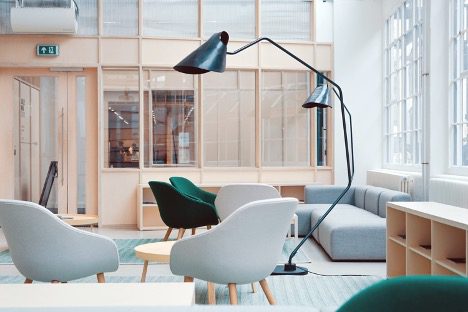Each month, we are examining the core principles of one of the ten concepts of the WELL Building Standard. The Standard identifies over 100 performance metrics, design strategies, and policies that are divided into ten sections or concepts: Air, Water, Nourishment, Light, Movement, Thermal Comfort, Sound, Materials, Mind, and Community. This month, we’re learning more about the Sound Concept.

SOUND CONCEPT
INTRODUCTION
The WELL Building Standard is a set of guidelines that focus on enhancing the health and well-being of building occupants by addressing various factors that can impact their physical, mental, and emotional health. One of the key components of the WELL Building Standard is the sound concept, which aims to improve acoustic comfort and reduce noise levels in indoor environments.
The satisfaction level of occupants in a particular environment can be used to measure the acoustical comfort of the space. Sound, which is defined as the human response to mechanical vibrations through a medium like air, is crucial in shaping the sonic environment, as it is dependent on human perception.
GOALS
The challenge of designing a single space to meet the acoustical comfort needs of every individual is rising due to the increase in hearing impairments and health concerns caused by over-exposure to noise. Nevertheless, best-practice acoustical design research suggests that a holistic approach to addressing acoustical comfort is achievable. This can be achieved through a balanced and isolated HVAC system, fortifying facade elements, adding mass and glazing to partition elements, replacing hard surfaces with absorptive materials, and introducing consistent background sound levels using a sound masking system. Such measures can reduce noise intrusion, increase occupant comfort, health, and productivity while also providing acoustical privacy. Some of the approaches defined in the WELL Building Standard include:
- implementing an acoustic design plan to reduce disturbances from various sources of noise
- designing for sound isolation at doors and walls to increase speech privacy between adjoining spaces
- designing with sound reducing materials such as resilient floors and upholstered furniture to minimize noise radiation and unwanted sounds
- implementing a sound masking system to increase acoustical privacy
- utilizing high-performance audio technology to improve speech intelligibility and accessibility
- providing access to resources and structured programming for employees at risk of occupational hearing loss
ISSUES ASSOCIATED WITH SOUND DISCOMFORT
- Distraction: High levels of noise can be distracting and disrupt concentration, making it difficult to focus on tasks such as studying, working, or communicating.
- Stress: Prolonged exposure to high levels of noise can cause stress, which can have negative impacts on mental and physical health, such as increased blood pressure and heart rate.
- Sleep disturbance: Noise can also disrupt sleep and lead to sleep disturbances, which can have negative impacts on cognitive function, mood, and overall health.
- Speech intelligibility: High levels of ambient noise can make it difficult to understand speech, particularly for individuals with hearing impairments or for those communicating in a second language.
- Hearing damage: Exposure to high levels of noise over an extended period of time can cause hearing damage, which can be irreversible.

WAYS TO IMPROVE ACOUSTIC COMFORT
- Sound insulation: This involves using materials such as insulation, double-paned windows, and door seals to reduce the amount of outside noise that enters a space.
- Sound absorption: This involves using materials such as acoustic ceiling tiles, carpeting, and upholstered furniture to absorb sound waves and reduce echo and reverberation in a space.
- Sound masking: This involves the use of white noise, pink noise, or other ambient sound sources to mask distracting noises and create a more comfortable acoustic environment.
- Room layout and design: The layout and design of a room can affect its acoustic properties. For example, placing sound-absorbing materials on walls that face a busy street can help reduce the impact of outside noise.
- Soundscapes: Creating intentional soundscapes, such as playing calming music or natural sounds like waterfalls or bird sounds, can help create a more relaxing and comfortable environment.
- Use of partitions: The use of partitions, such as screens or curtains, can help to absorb and diffuse sound waves, reducing the transmission of noise from one area to another.
By implementing these measures, the WELL Building Standard aims to improve acoustic comfort and reduce noise levels in indoor environments, leading to improved health, productivity, and overall well-being.
At TSD we believe it is important for both professionals (architects, interior designers, and contractors) as well as building users (homeowners, business owners, school administration, maintenance personnel, etc.) to understand the problems as well as the potential solutions for creating and maintaining healthy interior spaces. By addressing the issues of sound discomfort, it is possible to create indoor environments that are more comfortable, productive, and conducive to overall health and well-being.
If you want to know more about making your home or office a safer and healthier environment, reach out to us by email or DM us on Instagram. Also, stay tuned next month when we introduce the eighth WELL concept: Materials.

Taleah Smith Design is an interior design studio based in Vancouver, British Columbia. We specialize in interior design that promotes wellness and sustainability. We believe your living space should promote a greater sense of health and wellbeing, and we approach this goal from many difference angles. If you would like to discuss a project, you can reach out to us here.
We also provide resources and consulting for other interior designers looking to integrate wellness and sustainability into their design practices. If you would like to learn more, contact us here.